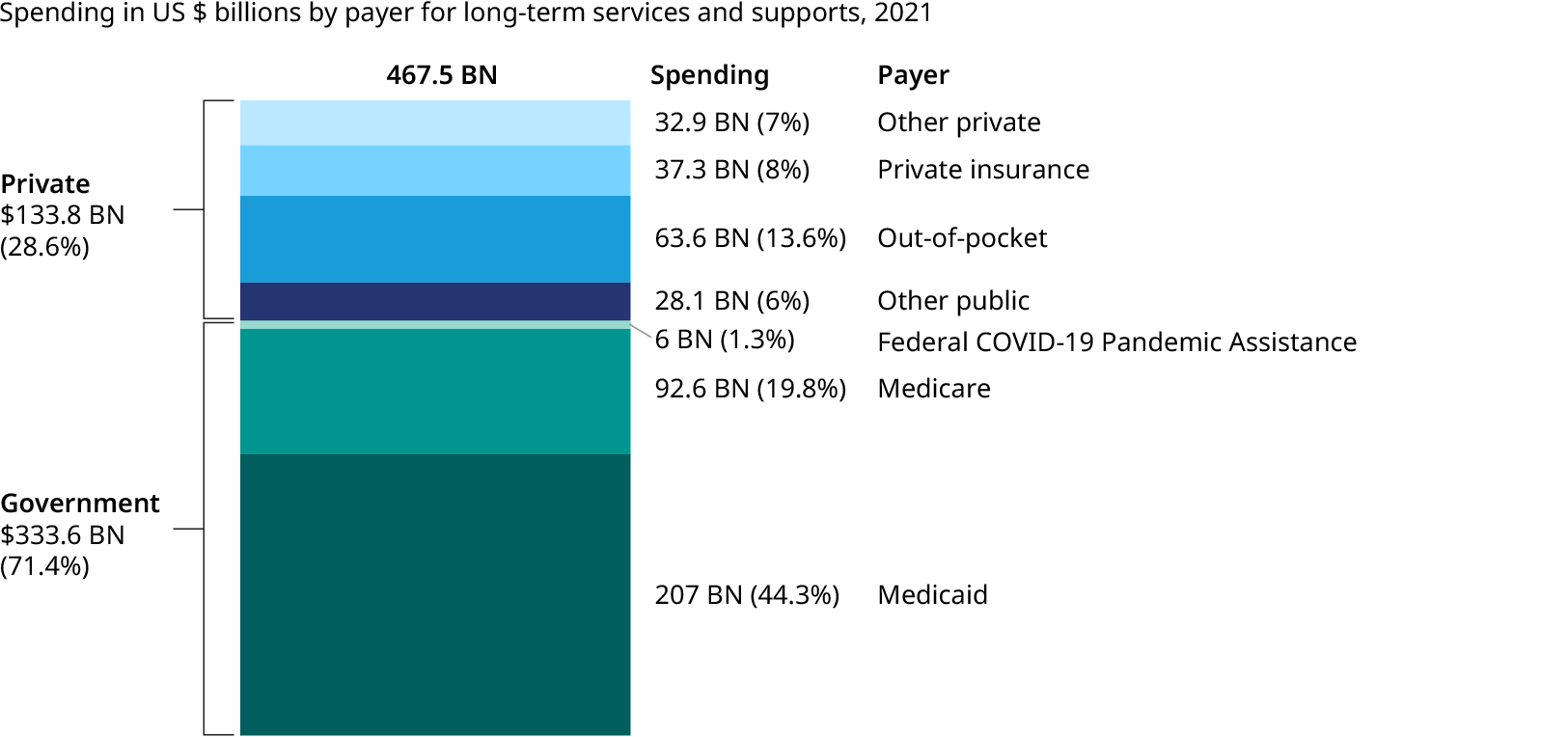As the aging of America starts coloring the population gray, another color comes to mind — green. How we plan for and fund long-term is a problem rippling across all sectors of the healthcare industry and government coffers. As the chart below shows, the financial pressure on all payers is immense, especially Medicaid and Medicare. The struggle for families and caregivers is equally problematic, as spotlighted by AARP, as well as analyses in the Wall Street Journal, KFF Health News/New York Times, and elsewhere.
Putting long-term care on a sustainable trajectory requires a host of policy solutions and system redesign. There are, however, actions stakeholders can take now to put the industry on better footing, ranging from advancing value-based care models to working closely with community organizations. We detail some of those solutions below. But first, it is important to understand the set of problems we face.
Seniors struggle with access, financial difficulties
The data is irrefutable: The number of Americans 65 years of age and older is projected to climb roughly 50%, reaching 82 million by 2050. The number of people 85 years of age or older will nearly triple to 19 million. Even before we account for this growth, there is sizeable supply problem. A previous Oliver Wyman analysis found that there are currently 3 million nursing home and assisted facility beds nationwide. The long-term care industry is also experiencing a significant workforce crisis, losing almost 229,000 caregivers since February 2020 and more than 95% of facilities have of staffing shortage, according to data from the American Health Care Association and National Center for Assisted Living.
For seniors and caregivers, the supply and financial crunches come on top of having to navigate a complex web of eligibility requirements laid out by different states, since long-term care is primarily covered through Medicaid. There are serious geographic disparities in long-term care access, particularly in rural areas where the availability of facilities and providers can be even more limited. Waiting lists for certain services can also delay access to timely and appropriate care. Even if seniors gain access to a facility, coverage limitations, coupled with increasing, costs exert a severe financial strain.
Challenges facing healthcare stakeholders
Seniors aren’t alone in this struggle. Various sectors of the industry have their own set of challenges. Health systems grapple with increased strain on hospital capacity when patients are unable to transfer to a long-term care facility. Patients who cannot be discharged due to a lack of options experience longer hospital stays, increasing costs and potentially delaying their recovery. This can create a backlog of patients waiting for discharge, and a shortage on acute-care beds, further straining hospital resources.
Payers face similar challenges which manifest differently in terms of cost of care. When individuals lack appropriate long-term care, they may require more frequent hospitalizations or emergency services, leading to higher healthcare costs. Without sufficient home-based care, many individuals may need a longer length of stay at acute care facilities or to be placed in nursing homes, which are often more expensive than long-term care facilities. In extreme cases, as individuals exhaust their personal finances, they may become eligible for Medicaid.
Finding the right mix of answers
Developing solutions requires a multifaceted and multi-player approach. It will take government, private payers, providers, and the broader community at large all working in concert. A critical first step is for payers and providers to make investments that not only support operations now but build toward a more sustainable future. The two sides need to collaborate on bolstering programs that ensure patients can be discharged safely and at the appropriate time to a long-term care facility which will free up scarce acute care beds. Key investment areas include:
- Payers and product innovation: Offer financial protection against the high costs of long-term care services by combining traditional long-term care coverage with other benefits, such as life insurance or disability insurance. Additional innovations include enhancing hospice benefit to include a broader range of services, such as respite care for caregivers, bereavement support, and home modifications to improve safety and accessibility.
- Payers and providers and system redesign: Payers and providers should explore value-based payment models that incentivize providers to deliver high-quality, cost-effective long-term care services. These models could focus on outcomes such as improved functional status, reduced hospitalizations, and enhanced patient satisfaction. Stakeholders should also promote home health services as a cost-effective and patient-centered alternative to institutional care. That includes investing in telehealth technologies and remote monitoring systems to enhance the reach and effectiveness of home health programs. We also recommend that payers and providers offer comprehensive palliative care programs that address the physical, emotional, and spiritual needs of individuals with serious illnesses. Early integration of palliative care can improve quality of life, reduce unnecessary hospitalizations, and potentially delay the need for more intensive long-term care services. Importantly, working with and promoting awareness about the importance of long-term care with the broader community is key. That includes encouraging encourage community members to volunteer their time at long-term care facilities, raising the need for more workers, and collaborating with community colleges to offer healthcare-related programs and internships to bridge the supply shortage.
Beyond industry-led efforts, broader policy changes are needed. Since most long-term care benefits are funded through Medicaid and Medicare, policy reforms are critical to remediate the supply shortage; both from a facility and workforce standpoint. Over the long term, incentives for both public and private sector to invest in long-term care facilities is essential — not just to build these facilities but to appropriately reimburse to ensure ongoing operational viability. Policy and funding solutions are also needed to solve the workforce shortage. Ensuring there is an adequate and steady supply of workers is especially important given new federal rules mandating staffing levels at nursing homes. The rule, which is being challenged in court, will be phased in through May 2026 when it takes full effect. It requires nursing homes to provide each patient with at least 3.48 hours of nursing care per day. Advancing policies that bolster recruitment and training for long-term care staff is critical. And finding funding to improve wages and benefits for healthcare workers will become table stakes for industry players.
Creating a more sustainable path for long-term care won’t be easy. But kicking the can further down the road will only worsen the problem for seniors, families, and the industry. We can better empower stakeholders to come up with innovative solutions by embracing these short- and mid-range solutions.



